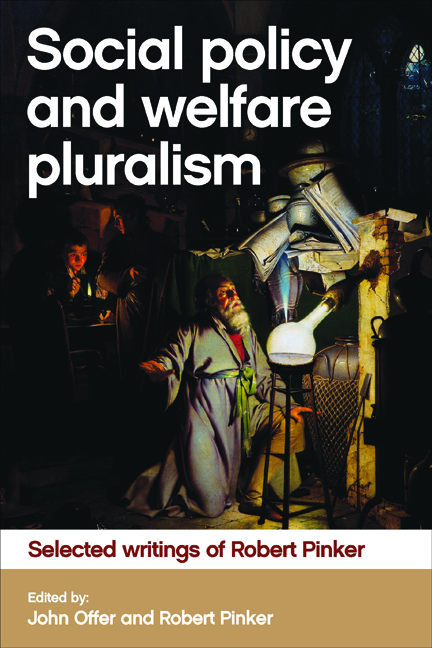Book contents
- Frontmatter
- Contents
- Acknowledgement
- Preface
- General introduction: Robert Pinker on rethinking approaches to welfare
- Introduction to Part One On social policy studies
- one The ends and means of social policy: a personal and generational perspective
- two Social theory and social policy: a challenging relationship
- three Stigma and social welfare
- four The welfare state: a comparative perspective
- five Richard Titmuss and the making of British social policy studies after the Second World War: a reappraisal
- Introduction to Part Two On social care, communities and the conditions for well-being
- six Report of the Working Party on the Role and Tasks of Social Workers: an alternative view
- seven The quest for community: from the Settlement Movement to the Griffiths Report: an historical perspective
- eight Citizenship, civil war and welfare: the making of modern Ireland
- Introduction to Part Three On welfare pluralism
- nine Golden Ages and welfare alchemists
- ten From gift relationships to quasi-markets: an odyssey along the policy paths of altruism and egoism
- eleven The experience of citizenship: a generational perspective
- twelve The right to welfare
- thirteen The prospects for social policy in the UK after the 2015 General Election
- Afterword On the post-Brexit prospects for social policy in the UK
- References
- Index
Afterword On the post-Brexit prospects for social policy in the UK
Published online by Cambridge University Press: 08 April 2022
- Frontmatter
- Contents
- Acknowledgement
- Preface
- General introduction: Robert Pinker on rethinking approaches to welfare
- Introduction to Part One On social policy studies
- one The ends and means of social policy: a personal and generational perspective
- two Social theory and social policy: a challenging relationship
- three Stigma and social welfare
- four The welfare state: a comparative perspective
- five Richard Titmuss and the making of British social policy studies after the Second World War: a reappraisal
- Introduction to Part Two On social care, communities and the conditions for well-being
- six Report of the Working Party on the Role and Tasks of Social Workers: an alternative view
- seven The quest for community: from the Settlement Movement to the Griffiths Report: an historical perspective
- eight Citizenship, civil war and welfare: the making of modern Ireland
- Introduction to Part Three On welfare pluralism
- nine Golden Ages and welfare alchemists
- ten From gift relationships to quasi-markets: an odyssey along the policy paths of altruism and egoism
- eleven The experience of citizenship: a generational perspective
- twelve The right to welfare
- thirteen The prospects for social policy in the UK after the 2015 General Election
- Afterword On the post-Brexit prospects for social policy in the UK
- References
- Index
Summary
In Chapter Thirteen, I reviewed some of the key trends in UK social policy between May 2015 and the end of March 2016. By the time the page proofs were returned to us in August, however, the UK electorate had already voted to leave the EU (for ‘Brexit’) by a narrow but decisive majority on 23 June 2016. The implications of this vote were momentous, reaching far beyond the prospects for social policy to encompass every kind of policy making, including what needed to be done to ensure the survival of the United Kingdom itself as a united political entity.
The EU Referendum and its outcome
In the run-up to polling day, both the ‘Remainers’ and the ‘Leavers’ resorted to negative forms of campaigning and the publication of misleading and inaccurate news. The ‘Remainers’ ran what was widely considered to be a campaign designed to evoke widespread fear of the appalling consequences that would immediately follow a vote to leave the EU. The ‘Leavers’ misleadingly claimed that all of the £350 million currently paid every week to the EU could be redirected to increase the budget of the NHS immediately after Brexit was achieved. The ‘Leavers’ also launched a fear campaign of their own regarding countries which were in the process of seeking accession to the EU. They claimed that if Britain did not regain control over its own borders it would eventually be overwhelmed by thousands of Turkish, Macedonian, Montenegrin, Serbian and Albanian immigrants. It was this perceived need for stricter border controls, rather than the state of the economy that became the key concern of many voters during the last two weeks of the campaign.
And so it came about that on 23 June, 78 per cent of the UK electorate went to the polls and voted 52 per cent to 48 per cent for Brexit. England voted 53 per cent to 47 per cent for Brexit, along with Wales, which voted 52 per cent to 48 per cent. Scotland voted to remain by a massive 62 per cent to 38 per cent and Northern Ireland did likewise by 56 per cent to 44 per cent.
- Type
- Chapter
- Information
- Social Policy and Welfare PluralismSelected Writings of Robert Pinker, pp. 295 - 310Publisher: Bristol University PressPrint publication year: 2017

